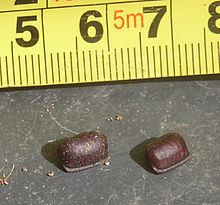Ootheca
As ootheca ( Pl. Oothecae; . Give a wiki ὠόν oon "egg" and gr. Θήκη counter "place to keep") refers to the Eipaket where cockroaches (Blattodea) and Mantis their (Mantodea) eggs drop. Some systematists therefore combine both orders in the taxon oothecaria or oothecariformia (see also the systematics of gladiators ). Oothecae are compact, firm and species-specific cocoons in which the eggs are inseparably glued together and which are laid in one place like clutches .
function

Ootheca serve to protect the eggs from mechanical, but also chemical and other environmental influences such as predators and the weather. In humid habitats, a smooth surface protects against soaking, in dry regions the surface is porous. The chambered walls insulate against cold and heat. The cockroach's oothecae are particularly resistant to alkalis , acids and other chemicals.
Cockroach oothecae
In many cockroaches, the cocoons are either deposited shortly after the ootheca is fully hardened or some time later. Certain species hide the oothecae while others just drop them. Depending on the type, 15 to 40 eggs are placed in a package. The female of the common cockroach ( Blatta orientalis ) produces about 12 millimeters long, dark brown, smooth-walled egg capsules with a seam in which it lays 16 eggs, which it carries on its body for almost two days. Some species such as the Argentine cockroach ( Blaptica dubia ), the death's head cockroach ( Blaberus craniifer ) and Madagascar hissing cockroach ( Gromphadorrhina portentosa ) carry these over the entire period up to the hatching of the nymphs in a specially designed genital bag of the females around, which have a shape which is ovoviviparic .
Oothecae of the terrors

In contrast to the free oothecae of the cockroaches, the catch terrors stick their round, elongated, shield-like, teardrop-shaped or packet-like oothecae to different substrates . To do this, they first apply a protein-containing secretion to the substrate. With spiral movements of the abdomen , even more of this foamy secretion is released, with the eggs being deposited one after the other in the same so that they are in a certain arrangement to one another and each occupy a compartment of the ootheca. Finally, the secretion is drawn out in a more or less long thread before it hardens into a spongy, very firm cocoon. The thinnest-walled area from which the nymphs hatch is located along the surface. It can usually be recognized as a large-pored, seam-like or comb-like strip. The number of eggs in the oothecae varies between 15 and 400, depending on the species and cocoon size. Since the females deposit five to well over twenty oothecae depending on the species, a total of more than 1000 eggs can easily be laid.
Oothecae of the double-footed
Different species of bipedal bipedes (Diplopoda) are also able to coat the eggs of a clutch with different substrates. The resulting structures are also called oothecs. For example, the put Schnurfüßer (Julida) and the Bandfüßer (Polydesmida) several dozen to several hundred eggs in small holes in the ground from whose walls are hardened by a secretion. Seed pods (Chordeumatidae) spin their eggs into a web.
swell
- ↑ a b c K. Günther, H.-J. Hannemann, F. Hieke, E. Königsmann & H. Schuman: Urania animal kingdom - insects. Urania-Verlag, Leipzig, Jena, Berlin 1994, ISBN 3-332-00498-0
- ↑ Oliver Zompro: The system of winged insects (Pterygota) , Arthropoda 16 (1) March 2008, Sungaya-Verlag Kiel. ISSN 0943-7274
- ^ Erich Kleinsteuber: Small animals in the terrarium , Urania-Verlag Leipzig Jena Berlin 1998. ISBN 3-332-00273-2
- ↑ www.diplopoda.de - For the egg-laying of the diplopods
